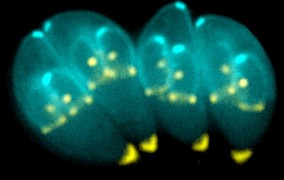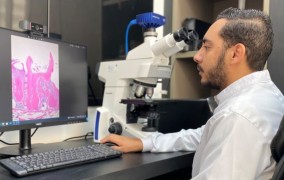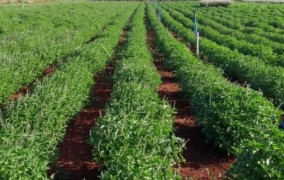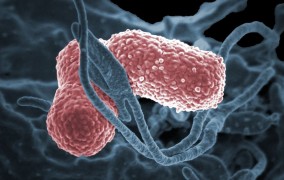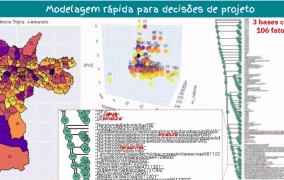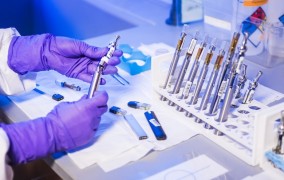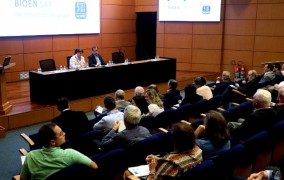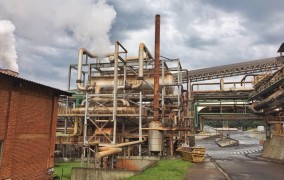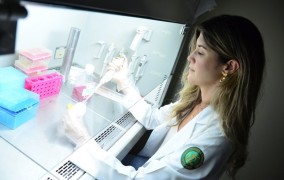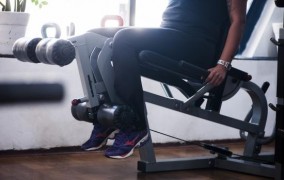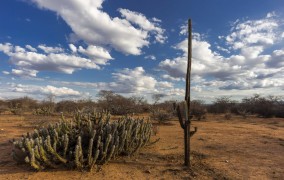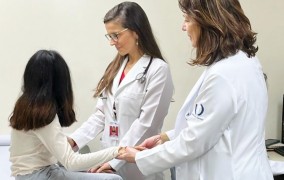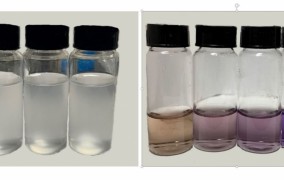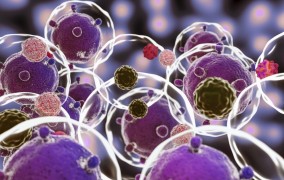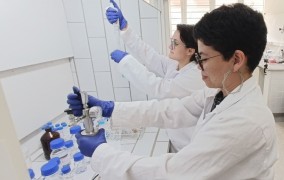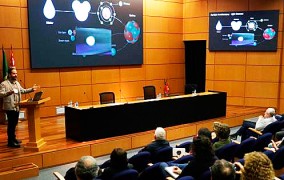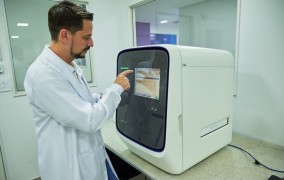
Search: 4362 news
-
FAPESP assembles experts to discuss the Amazon during UN Science Summit in New York
2023-10-04‘Amazon Day: Science for the Amazon’ was held on September 15, during the 78th United Nations General Assembly. Panelists discussed the role of science, technology and innovation in sustainable development for the region. -
Study identifies six drugs that can be repurposed for treatment of toxoplasmosis
2023-10-04Brazilian researchers screened 160 compounds known to be effective against SARS-CoV-2 and identified those that also act against the protozoan parasite Toxoplasma gondii. The most promising will be tested in humans for treatment of the chronic form of the disease. -
Discovery of mechanism involved in dental inflammation paves way to therapies against bone loss
2023-10-04Researchers at the University of São Paulo showed in mice the importance of the signaling pathway mediated by the pro-inflammatory cytokine TNF-α and its receptor TNFR1; the discovery could now help scientists develop medications for oral health. -
Biofungicide based on essential oils developed to combat soybean disease
2023-10-04The technology was invented by a FAPESP-supported startup. It consists of a blend of essential oils from various plants, encapsulated in natural polymers that release the biofungicide gradually over a long period. -
Amazon+10 Initiative and CNPq issue new call to support scientific expeditions in the region
2023-10-04Subnational funding agencies and Brazil’s National Scientific Council will partner to allocate almost BRL 60 million to research projects that explore little-known areas of the world’s largest tropical forest. -
Study shows how ‘superbacteria’ were prevented from spreading in a large tertiary hospital
2023-10-02The study was conducted by researchers at the University of São Paulo, highlighting the importance of identify and isolating infected patients on admission to the emergency room. The findings also showed that containment may be impaired if patients stay more than two days in the ER. -
Tool uses artificial intelligence in support of decisions on actions to combat hunger
2023-09-27Algorithms developed at the University of São Paulo interpret information from different databases and help identify city areas susceptible to food insecurity. -
FAPESP issues call for investment funds to boost support for innovation
2023-09-27The call is one of several initiatives designed by FAPESP to help science and technology startups supported by its entrepreneurship and innovation program attract investors and survive “death valley”. -
Specialists discuss priorities for energy transition in aviation
2023-09-27A seminar hosted by the steering committee for the FAPESP Bioenergy Research Program featured researchers and representatives of the public and private sectors. A rapid and substantial increase in production of sustainable aviation fuels was the option considered most consistent. -
Researchers create formula for first synthetic sugarcane molasses with fully reproducible composition
2023-09-27The product will pave the way for researchers and food engineers to develop novel industrial processes based on the use of sugarcane molasses. It was tested as a yeast culture medium for ethanol production. -
Study could lead to treatment for a type of cancer that affects children’s endocrine system
2023-09-27Experiments conducted at the University of São Paulo showed that expression of the gene that encodes the vitamin D receptor is greatly reduced in pediatric adrenocortical tumor cells. When the gene was activated, an anti-proliferation effect was observed. The only treatment currently available is surgical removal of the tumor. -
Risk of eating disorders among vegan diet followers is low, study suggests
2023-09-27The prevalence of dysfunctional eating behaviors among almost 1,000 vegans studied by researchers at the University of São Paulo was less than a tenth of the average for the Brazilian population. The explanation, according to the researchers, lies in the reasons for which people choose a restrictive diet. -
Understanding of mechanisms behind post-exercise lack of appetite can open new paths to obesity treatment
2023-09-26Hormones and metabolites secreted after physical activity act together to suppress hunger, as highlighted by an editorial in The Journal of Physiology written by researchers at the State University of Campinas and the University of Copenhagen. -
Artificial intelligence improves shipping forecasts in port areas
2023-09-25A technology created by the University of São Paulo’s Center for Artificial Intelligence increases the accuracy of shipping and other weather forecasts by 20%, and is being tested at the Port of Santos. -
Climate change may affect 40% of biodiversity in semi-arid portion of Brazil’s Northeast by 2060
2023-09-20The main impacts for the Caatinga, as the semi-arid biome is known, will be replacement of trees by shrubs and grasses, and a decrease in the overall number of species. The projections are based on the IPCC’s latest report and a database created by Brazilian researchers. -
Researchers develop biodegradable optical fiber to measure or modulate electrical current in the body
2023-09-20Made from agar, a substance extracted from red algae, the optical fiber can be used to monitor stimuli produced in the brain or muscles, or as an ancillary interface in human-computer connections for assistive or rehabilitation technologies. -
Genetic mutation leads to precocious puberty associated with neurological disturbances, study shows
2023-09-20Researchers at the University of São Paulo in Brazil and collaborators in four other countries analyzed more than 400 patients. They found a link between the endocrine disorder and alterations in the gene MECP2, which encodes a protein of key importance to neuron development. -
Brazilian researchers develop method of purifying water contaminated by glyphosate
2023-09-20The technique uses functionalized cellulose fibers from sugarcane bagasse to remove residues of the herbicide from an aqueous medium. -
AI-assisted platform helps patients control diabetes and prevent complications
2023-09-20A startup supported by FAPESP is developing an app that leverages artificial intelligence to help users monitor the disease and improve the quality of their lives. -
Cell therapy can reduce risk of death from COVID-19 by 60%, study shows
2023-09-18Brazilian researchers and collaborators in Germany and the US compiled data from 195 clinical trials conducted in 30 countries between January 2020 and December 2021. The findings are promising, although the authors stress the need for enhanced controls in the making of the products used in cell therapy. -
New ‘encyclopedia’ of sedentary behavior emphasizes importance of movement to health
2023-09-13A comprehensive review by researchers in Brazil and elsewhere provides a wealth of information about the effects on the organism of remaining seated for much of the day, and calls for more research to analyze the effectiveness of interventions to reduce or interrupt sedentary behavior. -
A novel method to obtain acetone more simply, safely and cheaply
2023-09-13Acetone, a key input for the chemical industry, is usually produced by an elaborate and hazardous process. A more sustainable strategy has been developed by a scientific collaboration between researchers in Brazil and Germany. -
Study suggests paternal diet can influence propensity to obesity in offspring
2023-09-13Researchers at the Federal University of São Paulo conducted experiments involving rats to analyze the effects of a high-fat high-sugar parental diet. The results suggested that ingestion of hypercaloric food by male progenitors favors weight gain and a build-up of body fat in their offspring. -
Hydroelectric power plants in Brazil threaten turtles that depend on rapids, study warns
2023-09-13The researchers correlated data on the animal’s ecological niche and connectivity among populations with existing and planned hydropower development sites in Brazil’s South region. They estimated that 30% of its habitat could be lost, heightening the risk of extinction. -
iSystems implements AI-based solution for biofuel production
2023-09-13A software tool developed by a company supported by FAPESP raises productivity and lowers operating costs in the bioenergy sector. -
Legal mining sites in Brazil store 2.55 gigatonnes of CO2 in vegetation and soil, study estimates
2023-09-13Researchers at the University of São Paulo highlight the importance of monitoring these areas and advocate the use of technosols based on tailings and other waste to offset part of their emissions. -
New beamlines at Sirius make more possibilities available to Brazilian science
2023-09-06The fourth-generation particle accelerator installed at the Brazilian Synchrotron Light Laboratory (LNLS) was the topic for the 4th FAPESP Lecture 2023. LNLS Director Harry Westfahl Junior described the facility and the research opportunities it offers. He also announced the third call for proposals. -
A thyroid tumor diagnostic test wins Octavio Frias de Oliveira Award
2023-09-06Technology developed with FAPESP’s support was the winner in the “Technological Innovation” category. Also, a University of São Paulo study that found a molecule capable of killing leukemic cells was awarded in “Oncology Research” category. -
COVID-19 can trigger auto-immune disorders-related antibodies, causing thrombosis and other complications
2023-09-06A study conducted at the University of São Paulo helps explain why older people are more susceptible to the severe form of the disease and why it involves blood clotting disorders. -
Santos estuary in Brazil has one of the highest levels of microplastic contamination in the world
2023-09-06Researchers sampled oysters and mussels at three locations between the port of Santos and the nearby city of Guarujá. Their aims included assembling data as a basis for public policy on basic sanitation. The law does not currently require removal of microplastic particles from sewage.
Most popular
-
Amazon scorpion toxin kills breast cancer cells
2025-06-18
-
Spending more than 3 hours a day sedentary worsens teens’ mental health
2025-02-20
-
Climate change could drastically reduce aquifer recharge in Brazil
2025-09-17
-
Microplastics may affect bone health
2025-09-17
-
‘Science alone will not save us’: Paulo Jannuzzi highlights the need for republican values
2025-09-17
-
Butantan Institute says its dengue vaccine protects against serotype 3
2025-02-05
-
FAPESP aims to boost the development of quantum technologies in Brazil
2025-01-15
-
Molecule reverses cognitive deficits associated with aging and dementia in animal tests
2025-05-12
-
Ants defend plants from herbivores but can hinder pollination
2025-09-15
-
Personality traits influence the development of insomnia
2025-05-19






